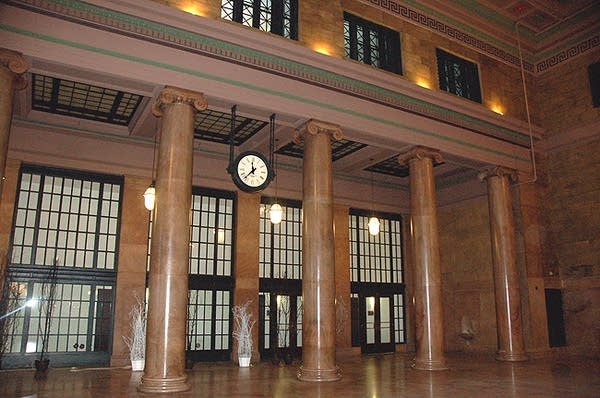Future links to past, as historic train depot is restored

Workers are already laying track for the Central Corridor Light Rail line between downtown Minneapolis and downtown St. Paul. The west end of the line will stop at Target Field.
The east end of the line line will be the Union Depot in St. Paul, and the renovation of that historic building has begun in earnest.
Construction workers at the World War I-era Union Depot are literally redoing the iconic train station from the ground up. They're driving piles into the ground under missing parts of the station's foot-thick concrete train deck.
"There were portions of the train deck that needed to be replaced," said Kevin Dalager, senior project manager with Mortenson Construction. "I'd say we are using about 70 percent of the train deck. But that 30 percent that we're demo-ing, we're now rebuilding."
Create a More Connected Minnesota
MPR News is your trusted resource for the news you need. With your support, MPR News brings accessible, courageous journalism and authentic conversation to everyone - free of paywalls and barriers. Your gift makes a difference.
Train backers hope to run commuter rail into St. Paul from North Branch and Hastings, and high speed rail from Chicago.
But that's a longer way off. In the near term, only light rail will use the depot, and it'll pull up to the station on the street out front.
Passenger trains haven't been on the depot's platform since the last Burlington Northern Zephyr pulled out of the station on April 30, 1971.

Passenger rail had already been declining when the depot was built in the 1920s, according to John Diers, a railroad buff who's writing a history of the station.
"Some of the railroad presidents didn't want to build a fancy depot like this. They thought it was a waste of money," Diers said. "And it turned out they were right. Because by the time it was completed in 1924, the passenger train was already in decline."
Transportation planners hope the depot will mark a turnaround for train travel. In the next few years they'll be linking up buses, bikes, taxis and even cars to the depot's train service.
Workers are renovating the depot to accommodate those other modes of travel. For example, they're carving a section out of the old train deck to build a bus ramp.
The steps from the front of the depot's facade have been torn off. A horse-and-wagon era carriageway, which runs underneath them, is going to be demolished. "And then we reconstruct it to a fashion where cars and automobiles can get through," said Dalager.

But the real restoration is going on behind the scenes right now — in the station's cavernous waiting room. Generations ago, its windows were boarded up, the skylights were blacked out and the doors were blocked. For years, the post office used the space as a warehouse for mail equipment.
It's one of the grandest and most celebrated indoor spaces in the Twin Cities.
To ready the waiting room for the public again, construction workers have already evicted the pigeons from the skylights to start cleaning the blackened glass.
Workers are also stripping paint from the historic window frames. The windows are being removed and shipped to Kansas City, MO for restoration.
Escalators will be installed where stairs used to run down to the tracks, and architects are recreating the historic light fixtures that once hung from the vaulted ceiling.
Crews are also cleaning decades of dirt and smoke from the building's stone. Paint samples are being taken to match the original colors.
The work makes way for the successors to the drug store, ticket office and diner that once made the depot a hub of activity.
"When the building is renovated, we're going to have all sorts of spaces that could be used for anything from coffee shops to maybe small business office space, restaurants or maybe even some artistic museum-type space," said Josh Collins, spokesman for the Ramsey County Rail Authority, which will own and operate the depot.
The refurbishment is scheduled for completion by the end of 2012. Amtrak trains are expected to use the depot regularly by 2013. Greyhound buses, and Metro Transit bus and light rail service will add service by 2014.
